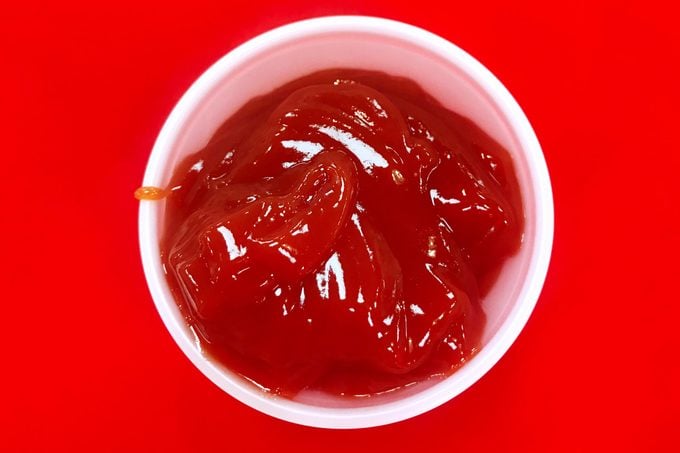The Surprising History of Ketchup Explained
Updated: May 13, 2024

Sure, ketchup is a beloved condiment in America today, but ketchup's origins are actually ancient. Discover the surprising history of the sauce.
Ketchup has long been one of the most popular condiments in the U.S., and the tangy, sweet topping has got the sales to back it up: Americans are expected to spend $5.85 billion on ketchup in 2023, according to Statista. That’s equivalent to every American spending more than $17 on it yearly. But the ketchup Americans know and love—the grilling staple squeezed on hot dogs and the best burgers in America—is a relatively new invention, when you consider the ketchup origin story.
Like prepared mustard, mayo, sriracha or ranch, ketchup is part of America’s condiment craze. Here, we’re diving into the surprising and fascinating history of the sauce. It’s a food fact you’ll want to share with your neighbor at the next cookout.
How was ketchup invented?
The origin of ketchup dates back thousands of years to southeast Asia, where it did not resemble the hamburger condiment we love today. “The story begins thousands of years ago, when people living along the coasts and rivers of southeast Asia and what is now southern China began to preserve local fish and shrimp, salting and fermenting it into rich savory pastes,” says Dan Jurafsky, a professor of linguistics at Stanford University and the author of The Language of Food. These pastes were confined to the region until Emperor Wu of Han began to expand the nation around 200 B.C. “Evidence demonstrates that it was during this period that the Chinese adopted these fish sauces,” he says.
For hundreds of years, these fermented fish sauces remained one of the most popular methods of flavoring food in this region of China, known today as Fujian—until sea travel and trade exposed the world to their flavors. “Fujianese traders and seamen loved the fish sauce, naming it ke-tchup, which means preserved fish sauce in Hokkien, the language of southern Fujian and Taiwan,” says Jurafsky.
So why the different spellings? “Hokkien isn’t written with the Roman alphabet, which explains why there are so many different spellings,” says Jurafsky. “Ke-tchup, cat-sup and ca-tchup are all attempts by English, Dutch or Portuguese speakers of the time to capture the sounds of the Chinese word.”
The words ketchup and catsup persisted as the recipe changed, even though the translation in Hokkien no longer applied. “The syllable ‘tch’ still means sauce in Hokkien and Mandarin, and the syllable ‘ke’ means preserved fish in Hokkien,” says Jurafsky. It was also around this time when Fujianese settlers began to travel to places like Indonesia, where they built factories for making traditional Chinese sauces like ke-tchup—and that’s where the British first discovered it.
The British ketchup origin story
In the early 1600s, British sailors who were traveling to Indonesia to trade began to develop a taste for ke-tchup. “Shipboard fare (salt pork and dried crackers) was pretty bland, so ke-tchup may have helped enliven their diet,” says Jurafsky. “But it’s also possible that traders figured they could market it back home as an exotic Asian sauce.” He adds that it’s likely in one of these Indonesian port cities that the word ketchup first came into the English language.
Before long, British sailors were purchasing large quantities of ketchup, bottling it and bringing it home. But like many imports, it was expensive, so the Brits started trying to make their own. A London cookbook from 1742 features a recipe for ketchup made with beer, anchovies (a nod to ketchup’s fermented fish origins), mushrooms, shallots and spices. “The mushrooms soon became a main ingredient, and from 1750 to 1850 the word ketchup began to mean any thin dark sauces made with mushrooms or even walnuts, often used to flavor melted butter,” says Jurafsky. These ingredients were used because the finished sauce kept for longer (here’s how long condiments last today).
The tomato ketchup origin story

The Brits were likely the first to add tomatoes to ketchup, notes Jurafsky. It was in the mid-1800s that the tomatoes replaced the mushrooms. Then anchovies disappeared from the recipes, along with the final nods to ketchup’s roots as a fermented fish sauce. But even though tomatoes were used, this sauce was still relatively brown and thin, not like modern ketchup.
Because tomatoes decompose faster than the other ingredients, it was in 1876 that Heinz produced the first ketchup made with vinegar to prevent decomposition.
The U.S. ketchup origin story
In the late 1800s, ketchup production and popularity began to rise in America. “After the Civil War, manufacturers in America responded to the greatly increased demand by increasing ketchup production, tailoring their recipes to American consumers, who began to prefer their ketchup a bit sweeter and thicker than the British,” Jurafsky says.
By around 1910, ketchup (especially Heinz) began to resemble the ketchup we dip McDonald’s fries and chicken nuggets into today. “Manufacturers like Heinz found that adding even more sugar and lots of vinegar helped produce a ketchup that preserved better, leading to our modern sweet-and-sour formula,” Jurafsky says.
Ketchup vs. catsup
British tea drinking wasn’t the only difference between the two countries. British vs. American spelling also played a role. “While both spellings were used in both countries, ketchup was more common in Britain and catsup in America, until about 30 years ago, when ketchup took over here as well.” When it began producing ketchup, Heinz originally chose to go with that spelling to differentiate its sauce from its competitors, like Hunt’s and Del Monte, who were using catsup.
“When Heinz began to dominate the market,” Jurafsky adds, “other manufacturers switched their spelling.”
The ketchup of today
The ketchup we eat today on hot dogs and fast-food burgers is actually quite similar to the Heinz recipe from the early 1900s. Tomatoes and distilled vinegar are still there, as are salt and spices like onion powder. Sugar from the original recipe has been replaced with high-fructose corn syrup, though Heinz also makes versions with no sugar added (sweetened with honey or stevia), if you’re looking to adopt some healthier grilling practices.
Heinz is also still the most popular, with more than twice as many Americans purchasing it as Hunt’s, the next brand up (their recipes are virtually identical). While ketchup is no longer the most popular condiment in America, ceding that title to mayonnaise in 2021, it is still used and loved widely.
Sources:
- Dan Jurafsky, professor of linguistics at Stanford University and author of The Language of Food
- Statista: “Tomato Ketchup – United States”
- Statista: “U.S. population: Which brands of catsup / ketchup do you use most often?”
- Statista: “Sales of condiment and dressing categories in the United States from 2019 to 2021”























